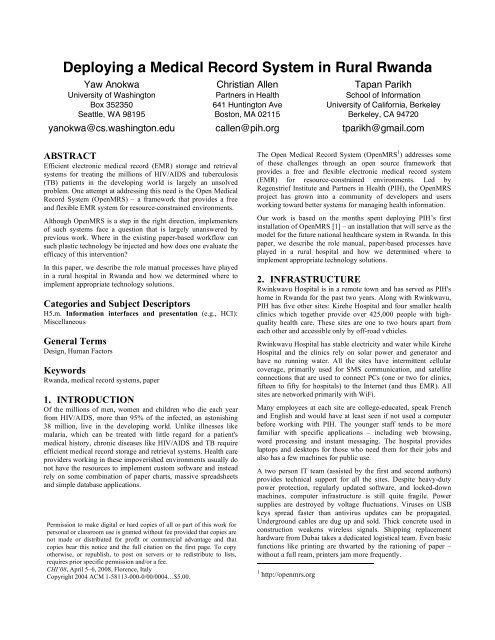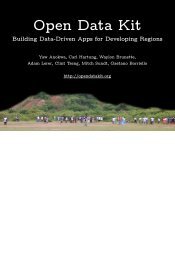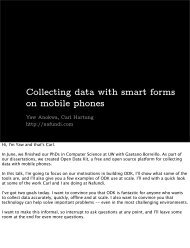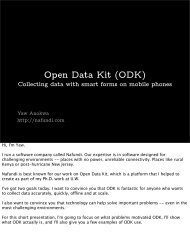Deploying a Medical Record System in Rural Rwanda - Yaw Anokwa
Deploying a Medical Record System in Rural Rwanda - Yaw Anokwa
Deploying a Medical Record System in Rural Rwanda - Yaw Anokwa
Create successful ePaper yourself
Turn your PDF publications into a flip-book with our unique Google optimized e-Paper software.
<strong>Deploy<strong>in</strong>g</strong> a <strong>Medical</strong> <strong>Record</strong> <strong>System</strong> <strong>in</strong> <strong>Rural</strong> <strong>Rwanda</strong><br />
<strong>Yaw</strong> <strong>Anokwa</strong><br />
University of Wash<strong>in</strong>gton<br />
Box 352350<br />
Seattle, WA 98195<br />
yanokwa@cs.wash<strong>in</strong>gton.edu<br />
ABSTRACT<br />
Efficient electronic medical record (EMR) storage and retrieval<br />
systems for treat<strong>in</strong>g the millions of HIV/AIDS and tuberculosis<br />
(TB) patients <strong>in</strong> the develop<strong>in</strong>g world is largely an unsolved<br />
problem. One attempt at address<strong>in</strong>g this need is the Open <strong>Medical</strong><br />
<strong>Record</strong> <strong>System</strong> (OpenMRS) – a framework that provides a free<br />
and flexible EMR system for resource-constra<strong>in</strong>ed environments.<br />
Although OpenMRS is a step <strong>in</strong> the right direction, implementers<br />
of such systems face a question that is largely unanswered by<br />
previous work. Where <strong>in</strong> the exist<strong>in</strong>g paper-based workflow can<br />
such plastic technology be <strong>in</strong>jected and how does one evaluate the<br />
efficacy of this <strong>in</strong>tervention?<br />
In this paper, we describe the role manual processes have played<br />
<strong>in</strong> a rural hospital <strong>in</strong> <strong>Rwanda</strong> and how we determ<strong>in</strong>ed where to<br />
implement appropriate technology solutions.<br />
Categories and Subject Descriptors<br />
H5.m. Information <strong>in</strong>terfaces and presentation (e.g., HCI):<br />
Miscellaneous<br />
General Terms<br />
Design, Human Factors<br />
Keywords<br />
<strong>Rwanda</strong>, medical record systems, paper<br />
1. INTRODUCTION<br />
Of the millions of men, women and children who die each year<br />
from HIV/AIDS, more than 95% of the <strong>in</strong>fected, an astonish<strong>in</strong>g<br />
38 million, live <strong>in</strong> the develop<strong>in</strong>g world. Unlike illnesses like<br />
malaria, which can be treated with little regard for a patient's<br />
medical history, chronic diseases like HIV/AIDS and TB require<br />
efficient medical record storage and retrieval systems. Health care<br />
providers work<strong>in</strong>g <strong>in</strong> these impoverished environments usually do<br />
not have the resources to implement custom software and <strong>in</strong>stead<br />
rely on some comb<strong>in</strong>ation of paper charts, massive spreadsheets<br />
and simple database applications.<br />
Permission to make digital or hard copies of all or part of this work for<br />
personal or classroom use is granted without fee provided that copies are<br />
not made or distributed for profit or commercial advantage and that<br />
copies bear this notice and the full citation on the first page. To copy<br />
otherwise, or republish, to post on servers or to redistribute to lists,<br />
requires prior specific permission and/or a fee.<br />
CHI’08, April 5–6, 2008, Florence, Italy<br />
Copyright 2004 ACM 1-58113-000-0/00/0004…$5.00.<br />
Christian Allen<br />
Partners <strong>in</strong> Health<br />
641 Hunt<strong>in</strong>gton Ave<br />
Boston, MA 02115<br />
callen@pih.org<br />
Tapan Parikh<br />
School of Information<br />
University of California, Berkeley<br />
Berkeley, CA 94720<br />
tparikh@gmail.com<br />
The Open <strong>Medical</strong> <strong>Record</strong> <strong>System</strong> (OpenMRS 1 ) addresses some<br />
of these challenges through an open source framework that<br />
provides a free and flexible electronic medical record system<br />
(EMR) for resource-constra<strong>in</strong>ed environments. Led by<br />
Regenstrief Institute and Partners <strong>in</strong> Health (PIH), the OpenMRS<br />
project has grown <strong>in</strong>to a community of developers and users<br />
work<strong>in</strong>g toward better systems for manag<strong>in</strong>g health <strong>in</strong>formation.<br />
Our work is based on the months spent deploy<strong>in</strong>g PIH’s first<br />
<strong>in</strong>stallation of OpenMRS [1] – an <strong>in</strong>stallation that will serve as the<br />
model for the future national healthcare system <strong>in</strong> <strong>Rwanda</strong>. In this<br />
paper, we describe the role manual, paper-based processes have<br />
played <strong>in</strong> a rural hospital and how we determ<strong>in</strong>ed where to<br />
implement appropriate technology solutions.<br />
2. INFRASTRUCTURE<br />
Rw<strong>in</strong>kwavu Hospital is <strong>in</strong> a remote town and has served as PIH's<br />
home <strong>in</strong> <strong>Rwanda</strong> for the past two years. Along with Rw<strong>in</strong>kwavu,<br />
PIH has five other sites: Kirehe Hospital and four smaller health<br />
cl<strong>in</strong>ics which together provide over 425,000 people with highquality<br />
health care. These sites are one to two hours apart from<br />
each other and accessible only by off-road vehicles.<br />
Rw<strong>in</strong>kwavu Hospital has stable electricity and water while Kirehe<br />
Hospital and the cl<strong>in</strong>ics rely on solar power and generator and<br />
have no runn<strong>in</strong>g water. All the sites have <strong>in</strong>termittent cellular<br />
coverage, primarily used for SMS communication, and satellite<br />
connections that are used to connect PCs (one or two for cl<strong>in</strong>ics,<br />
fifteen to fifty for hospitals) to the Internet (and thus EMR). All<br />
sites are networked primarily with WiFi.<br />
Many employees at each site are college-educated, speak French<br />
and English and would have at least seen if not used a computer<br />
before work<strong>in</strong>g with PIH. The younger staff tends to be more<br />
familiar with specific applications – <strong>in</strong>clud<strong>in</strong>g web brows<strong>in</strong>g,<br />
word process<strong>in</strong>g and <strong>in</strong>stant messag<strong>in</strong>g. The hospital provides<br />
laptops and desktops for those who need them for their jobs and<br />
also has a few mach<strong>in</strong>es for public use.<br />
A two person IT team (assisted by the first and second authors)<br />
provides technical support for all the sites. Despite heavy-duty<br />
power protection, regularly updated software, and locked-down<br />
mach<strong>in</strong>es, computer <strong>in</strong>frastructure is still quite fragile. Power<br />
supplies are destroyed by voltage fluctuations. Viruses on USB<br />
keys spread faster than antivirus updates can be propagated.<br />
Underground cables are dug up and sold. Thick concrete used <strong>in</strong><br />
construction weakens wireless signals. Shipp<strong>in</strong>g replacement<br />
hardware from Dubai takes a dedicated logistical team. Even basic<br />
functions like pr<strong>in</strong>t<strong>in</strong>g are thwarted by the ration<strong>in</strong>g of paper –<br />
without a full ream, pr<strong>in</strong>ters jam more frequently.<br />
1 http://openmrs.org
3. PAPER WORKFLOW<br />
Although EMR use <strong>in</strong> the Rw<strong>in</strong>kwavu Hospital began almost<br />
simultaneously with the scale-up of health care services, paper<br />
processes played a large role from the beg<strong>in</strong>n<strong>in</strong>g because such<br />
processes were well understood by staff and required less cost –<br />
f<strong>in</strong>ancial and otherwise. The example scenario below describes a<br />
part of the workflow that was implemented alongside the EMR.<br />
Alice has been cough<strong>in</strong>g a lot this month and has decided to go<br />
see a doctor. The last time Alice was at a hospital, she was treated<br />
for malaria. Accord<strong>in</strong>g to national policy, the details of that visit<br />
were written <strong>in</strong> a health notebook (her medical record) as well as<br />
<strong>in</strong> a register at the hospital where she was seen. Alice f<strong>in</strong>ds the<br />
notebook and beg<strong>in</strong>s the two-hour walk to Rw<strong>in</strong>kwavu.<br />
This is Alice’s first visit to Rw<strong>in</strong>kwavu Hospital and upon arrival<br />
is assigned a patient ID from a list of available IDs. She is seen by<br />
Dr. Chris a few hours later. Dr. Chris looks over her health<br />
notebook, takes her vital signs and after listen<strong>in</strong>g to her<br />
symptoms, fills out a lab request test form for TB and HIV tests.<br />
He asks her to wait another few hours for the test results.<br />
When the tests are ready, Dr. Chris sits down with Alice to<br />
expla<strong>in</strong> the results. The cough is a m<strong>in</strong>or <strong>in</strong>fection, but the blood<br />
test reveals that Alice is HIV+. Dr. Chris now fills out the long<br />
<strong>in</strong>take form and schedules a CD4 test. He notes his f<strong>in</strong>d<strong>in</strong>gs <strong>in</strong> her<br />
health notebook, schedules a return visit, and sends Alice home.<br />
A few days later, Alice returns to the hospital. Dr. Chris fills out a<br />
shorter return visit form to gather new <strong>in</strong>formation. He tells Alice<br />
that because her CD4 count is low and she will receive patient<br />
tra<strong>in</strong><strong>in</strong>g and be put on antiretroviral (ARV) drugs immediately.<br />
Every morn<strong>in</strong>g, Alice’s medications will be delivered to her house<br />
by an accompagnateur who will help her through the complex<br />
regimen. If she does not have access to food, she will also receive<br />
a food package. F<strong>in</strong>ally, a community health worker will also visit<br />
Alice occasionally and note her progress on yet another form.<br />
4. PLASTIC WORKFLOW<br />
Because of lessons learned <strong>in</strong>stall<strong>in</strong>g EMRs <strong>in</strong> Haiti and Peru,<br />
very specific choices were made at the beg<strong>in</strong>n<strong>in</strong>g of our<br />
deployment about where to add technology and where to absta<strong>in</strong>.<br />
Patients come to the sites with everyth<strong>in</strong>g from malaria to<br />
hippopotamus bites, but the EMR is primarily used for five<br />
thousand chronic care patients. This decision was made due to the<br />
importance of longitud<strong>in</strong>al records <strong>in</strong> chronic care, and because<br />
resources did not allow for ma<strong>in</strong>tenance of all patient records.<br />
Once Alice starts ARVs, she will visit the hospital every month.<br />
After each visit, the data entry team will enter all her new data<br />
<strong>in</strong>to the EMR. Rather than <strong>in</strong>cur the cost of tra<strong>in</strong><strong>in</strong>g and equipp<strong>in</strong>g<br />
each doctor to perform po<strong>in</strong>t of care entry (for example, us<strong>in</strong>g<br />
mobile devices), we f<strong>in</strong>d it more effective to rely on a dedicated<br />
data entry team us<strong>in</strong>g PCs.<br />
A lot of time is spent with the cl<strong>in</strong>ical team ensur<strong>in</strong>g the paper<br />
forms are concise, but still ask the medical and research questions<br />
necessary for good medical care. The design of the forms and<br />
specific questions has evolved over many years and is optimized<br />
for easy data entry and unambiguous analysis. The forms also<br />
allow for longer, free-text cl<strong>in</strong>ical notes that are best entered<br />
manually. Our data entry team is thoroughly tra<strong>in</strong>ed and is<br />
provided <strong>in</strong>centives to enter data quickly and accurately.<br />
The EMR is also used to generate patient IDs. Because of spell<strong>in</strong>g<br />
variations <strong>in</strong> names and the lack of a postal address<strong>in</strong>g system,<br />
duplication of patient records is prevalent <strong>in</strong> rural hospitals.<br />
Without a system to authorize and check IDs, hospital staff wastes<br />
considerable time process<strong>in</strong>g old patients. Importantly, by<br />
uniquely identify<strong>in</strong>g patients, hospitals can demonstrate real<br />
impact for the government and other donors. For example, Alice’s<br />
issued ID will l<strong>in</strong>k her data <strong>in</strong> the pharmacy and food program to<br />
her cl<strong>in</strong>ical care and show the impact of generic drugs and free<br />
food on patient outcomes.<br />
Once patients are tracked, it is also easier to generate program<br />
management reports and to trigger alerts when dangerous trends<br />
are found. For example, it is important for the hospital director to<br />
be alerted via email if a particular cl<strong>in</strong>ic is not do<strong>in</strong>g biannual<br />
CD4 tests for every HIV-positive patient.<br />
Enter<strong>in</strong>g lab data is another place the EMR is used. Although Dr.<br />
Chris’ request for lab data is written down and handed to a lab<br />
technician, who transcribes it <strong>in</strong>to a notebook, the actual test<br />
results, once generated, are automatically submitted to the EMR.<br />
Abnormal lab results also can be immediately sent via SMS to<br />
cl<strong>in</strong>ical staff. Low latency is essential for lab results, and thus test<br />
report<strong>in</strong>g was one of the first processes to be digitized.<br />
The f<strong>in</strong>al role the EMR plays is <strong>in</strong> generat<strong>in</strong>g consult sheets.<br />
When Alice’s HIV group is scheduled to visit the hospital, Dr.<br />
Chris will get one-row-per-patient consult sheets with weight,<br />
CD4 and regimen <strong>in</strong>formation. One-page patient summaries can<br />
also generated on demand, <strong>in</strong>clud<strong>in</strong>g graphs of weight, CD4 count<br />
and lab results; a history of symptoms, allergies and drug<br />
regimens; and alerts about dangerous trends. Cl<strong>in</strong>icians f<strong>in</strong>d these<br />
summaries essential to their work, and so computers with simple<br />
<strong>in</strong>terfaces to the EMR are also slowly be<strong>in</strong>g deployed.<br />
5. CONCLUSION<br />
In this paper, we have described the role manual, paper-based<br />
processes have played <strong>in</strong> our rural hospital <strong>in</strong> Rw<strong>in</strong>kwavu,<br />
<strong>Rwanda</strong> and how we determ<strong>in</strong>ed where and when to implement<br />
technology-based solutions.<br />
While we firmly believe that contextual knowledge is essential <strong>in</strong><br />
determ<strong>in</strong><strong>in</strong>g how to build and deploy such systems, there is also a<br />
need for more general guidel<strong>in</strong>es about the appropriateness of<br />
technology <strong>in</strong>terventions <strong>in</strong> manual, paper-based workflows. We<br />
believe that some of the choices we have made, and the reasons<br />
for them, could be applied <strong>in</strong> other contexts. For this reason, we<br />
are currently develop<strong>in</strong>g tools and methods that can <strong>in</strong>form<br />
system designers and implementers about the tradeoffs <strong>in</strong><br />
replac<strong>in</strong>g paper processes with plastic technology.<br />
6. ACKNOWLEDGMENTS<br />
The authors thank the NSF for their support and Gaetano Borriello<br />
and Neal Lesh for their <strong>in</strong>valuable contributions to this paper.<br />
7. REFERENCES<br />
[1] Fraser HSF, Allen C, et. al. Information <strong>System</strong>s for Patient<br />
Follow-Up and Chronic Management of HIV and Tuberculosis: A<br />
Life-Sav<strong>in</strong>g Technology <strong>in</strong> Resource-Poor Areas. J Med Internet<br />
Res 2007;9(4):e29.<br />
[2] Parikh, Tapan S. Design<strong>in</strong>g an Architecture for Deliver<strong>in</strong>g<br />
Mobile Information Services to the <strong>Rural</strong> Develop<strong>in</strong>g World,<br />
Ph.D. Dissertation, University of Wash<strong>in</strong>gton, 2007.





